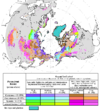permafrost

Definition: Permafrost is ground that continuously remains below 0 °C (32 °F) for two or more years, located on land or under the ocean. Most common in the Northern Hemisphere, around 15% of the Northern Hemisphere or 11% of the global surface is underlain by permafrost, with the total area of around 18 million km2. This includes substantial areas of Alaska, Greenland, Canada and Siberia. It is also located in high mountain regions, with the Qinghai–Tibet Plateau a prominent example. Most of the permafrost exists in the Northern Hemisphere, although some is known to exist in the Southern Hemisphere, where it is consigned to mountain slopes like in the Andes or the Southern Alps of New Zealand, and beneath the massive ice sheets of the Antarctic.In areas underlain by permafrost where the surface temperatures fluctuate annually above and below the freezing point, stable frozen temperatures may occur within a few centimeters of the surface down to hundreds of meters. It may be manifest as persistent ground ice or perennially frozen non-porous bedrock. Permafrost often comprises ice holding various types of soil, sand, and rock in combination.Permafrost contains large amounts of dead biomass which had accumulated throughout millennia without having had the chance to fully decompose and release its carbon, making tundra soil a carbon sink. As global warming heats the ecosystem, frozen soil thaws and becomes warm enough for decomposition to start anew, accelerating permafrost carbon cycle in one of the effects of climate change. Depending on conditions at the time of thaw, decomposition can either release carbon dioxide or methane, and these greenhouse gas emissions act as a climate change feedback.The emissions from thawing permafrost will have a sufficient impact on the climate to impact global carbon budgets. Exact estimates of permafrost emissions are hard to model because of the uncertainty about different thaw processes, but there's a widespread agreement they'll be smaller than anthropogenic emissions and not large enough to result in "runaway warming". Permafrost thaw also risks the collapse of buildings and other infrastructure which were built on it when it was stable, with estimates suggesting that nearly 70% of such infrastructure is at risk by 2050, and that the associated costs could rise to tens of billions of dollars in the second half of the century.
Source: Wikipedia
Wikipedia Page (Something wrong with this association? Let us know.)
Wikidata Page (Something wrong with this association? Let us know.)
Occurs in:


